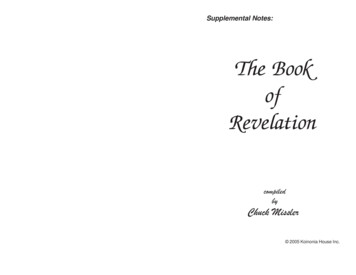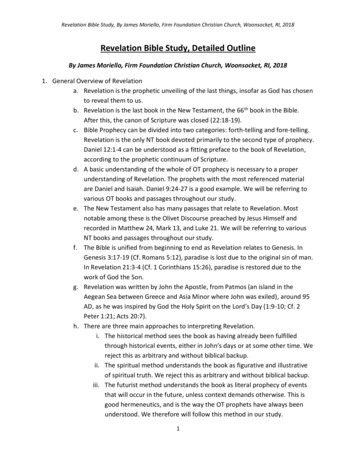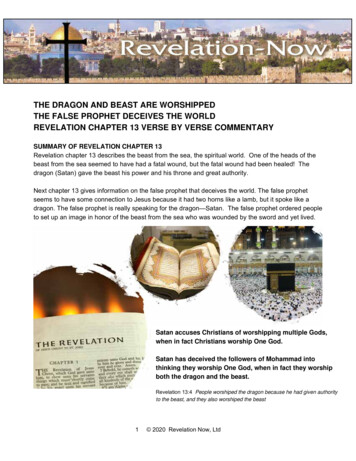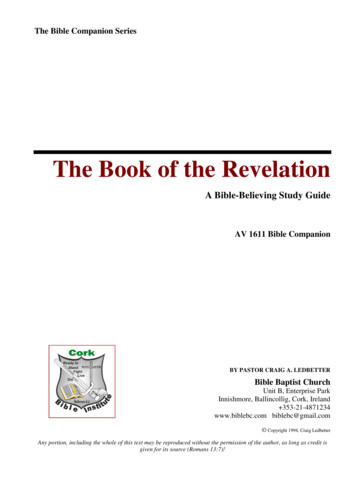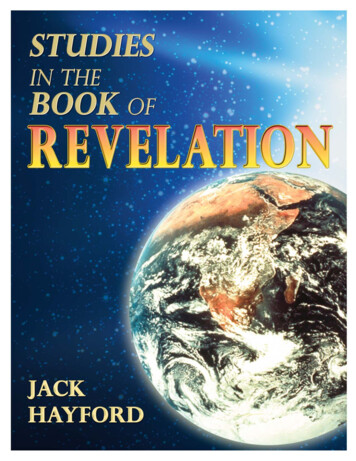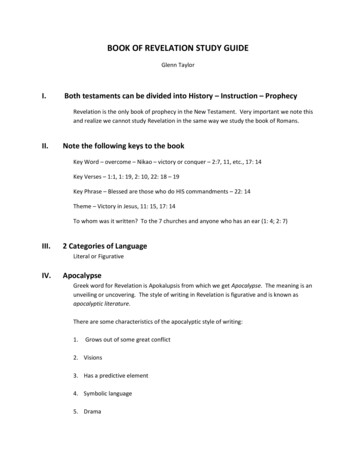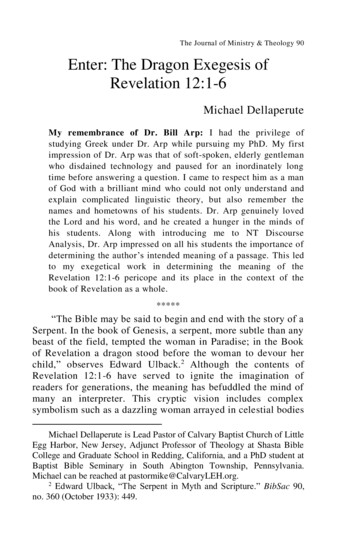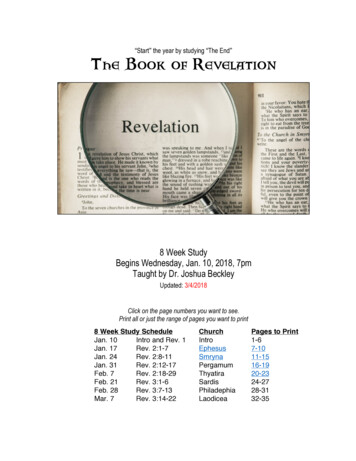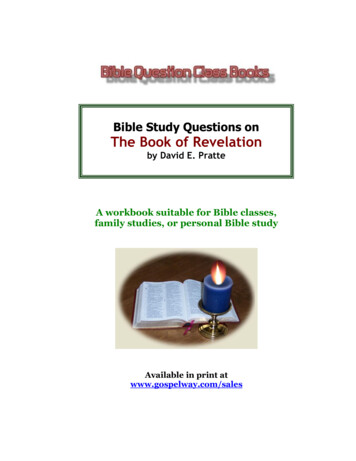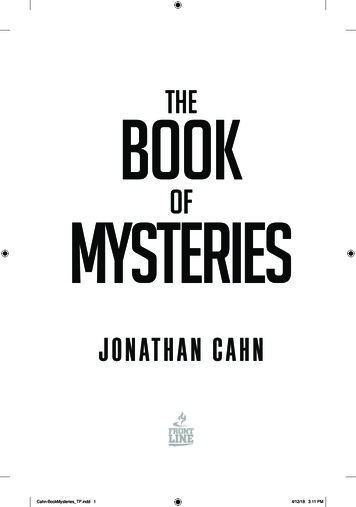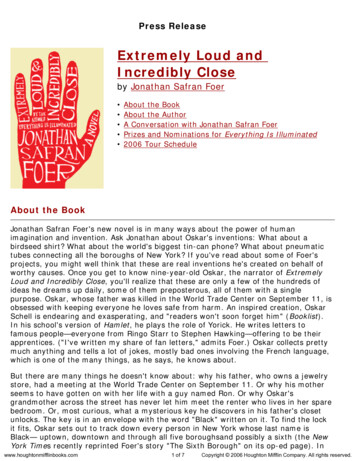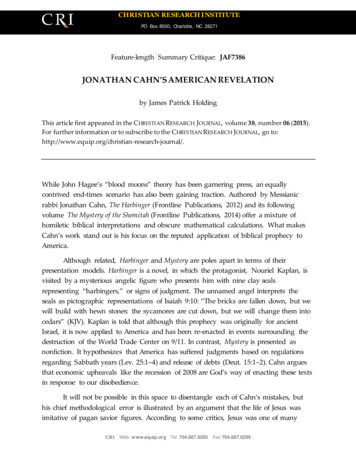
Transcription
CHRISTIAN RESEARCH INSTITUTEPO Box 8500, Charlotte, NC 28271Feature-length Summary Critique: JAF7386JONATHAN CAHN’S AMERICAN REVELATIONby James Patrick HoldingThis article first appeared in the CHRISTIAN RESEARCH JOURNAL, volume 38, number 06 (2015).For further information or to subscribe to the CHRISTIAN RESEARCH JOURNAL, go /.While John Hagee’s “blood moons” theory has been garnering press, an equallycontrived end-times scenario has also been gaining traction. Authored by Messianicrabbi Jonathan Cahn, The Harbinger (Frontline Publications, 2012) and its followingvolume The Mystery of the Shemitah (Frontline Publications, 2014) offer a mixture ofhomiletic biblical interpretations and obscure mathematical calculations. What makesCahn’s work stand out is his focus on the reputed application of biblical prophecy toAmerica.Although related, Harbinger and Mystery are poles apart in terms of theirpresentation models. Harbinger is a novel, in which the protagonist, Nouriel Kaplan, isvisited by a mysterious angelic figure who presents him with nine clay sealsrepresenting “harbingers,” or signs of judgment. The unnamed angel interprets theseals as pictographic representations of Isaiah 9:10: “The bricks are fallen down, but wewill build with hewn stones: the sycamores are cut down, but we will change them intocedars” (KJV). Kaplan is told that although this prophecy was originally for ancientIsrael, it is now applied to America and has been re-enacted in events surrounding thedestruction of the World Trade Center on 9/11. In contrast, Mystery is presented asnonfiction. It hypothesizes that America has suffered judgments based on regulationsregarding Sabbath years (Lev. 25:1–4) and release of debts (Deut. 15:1–2). Cahn arguesthat economic upheavals like the recession of 2008 are God’s way of enacting these textsin response to our disobedience.It will not be possible in this space to disentangle each of Cahn’s mistakes, buthis chief methodological error is illustrated by an argument that the life of Jesus wasimitative of pagan savior figures. According to some critics, Jesus was one of manyCRI Web: w ww.equip.org Tel: 704.887.8200Fax:704.887.8299
legendary deities that were “crucified.” But these critics have an expansiveunderstanding of what it means to be “crucified.” In their view, any deity depicted withhis or her arms outstretched—for whatever reason—ought to be deemed as “crucified.”This includes the Egyptian deity Shu, raising his arms to hold up the sky! In the sameway, Cahn pursues an agenda of generous conceptual expansion to facilitate whatappear to be uncanny matches.REINTERPRETING ISAIAH 9:10Cahn maintains that modern events saw a re-enactment of Isaiah’s words: the WorldTrade Center disaster re-enacted “bricks fallen down,” while the new Freedom Tower isa defiant “building with hewn stones.” A judicious reader might see in this little morethan coincidence, given that buildings are demolished and replaced by bigger or betterstructures constantly. There is also little evidence that the Freedom Tower is intended asa defiant response to God’s chastening (as opposed to being a defiant response to theideology of Islamic terrorists). However, Cahn asserts that the association with Isaiah9:10 becomes uncanny when we realize that the verse was incorrectly used as a“message of defiance” (p. 74)1 by American leaders in the aftermath of 9/11. Cahn notesthat Isaiah 9:10 was used in an address by then–Senate Majority leader Tom Daschle onthe third anniversary of the 9/11 disaster in 2004, and supposes it strange that out ofmore than thirty thousand Bible verses, Daschle featured Isaiah 9:10, which is so“obscure” that “people who read the Bible every day would probably have no idea thatit existed” (108).It is true that Daschle’s use of Isaiah 9:10 was contrary to the original intentionsof Isaiah. But there is nothing incredible about Daschle having used it, because Isaiah9:10 is not “obscure” at all. It was used as the title of a poem by the award-winningmodernist poet Marianne Moore in the early 1920s. More significantly, the text wasused in 1998 by President Bill Clinton as an encouragement to Floridians whose homeshad been destroyed by a hurricane. 2 In all probability, Clinton’s use of the text inspiredDaschle’s usage.Growing in the TellingContinuing his reapplication of Isaiah 9:10, Cahn connects the cutting down ofsycamores and the planting of cedars to modern events. As he explains, the collapse ofthe World Trade Center resulted in the destruction of a single tree, which was laterreplaced by a “Tree of Hope” (82). The tree felled in New York was, Cahn admits, notthe Middle Eastern sycamore of the Bible; it was an English sycamore. Likewise, the“Tree of Hope” was not a cedar; it was a Norwegian spruce.CRI Web: w ww.equip.org Tel: 704.887.82002Fax:704.887.8299
Cahn resolves this difficulty by way of generous conceptual expansion. It doesnot matter, he says, that the Middle Eastern “sycamore” is actually a type of fig treecompletely unrelated to the English sycamore; it only matters that both are designatedwith the same English word, sycamore. The failure in this argument is that the root wordfor sycamore, the Greek sukomoros, was widely applied to several different kinds of trees.The same phenomenon attends the English word sycamore, which has been applied totrees as varied as a European maple and an American plane tree. It is not a genericdesignation, but the term has been so widely applied that any suggestion ofuncanniness with respect to the events of 9/11 is unwarranted.Cahn’s generosity is even more pronounced with the second tree. He argues thatthe word “cedar” in Hebrew (erez) is “likely a generic word for the pine family” (90),and so the replacement of the American sycamore with a Norwegian spruce (also aconifer) fulfills Isaiah. The idea of a “pine family” of trees, however, did not come toexist until more than 1,500 years after the time of Isaiah, so the equation of erez withsuch a classification is questionable. In addition, the “pine family” is quite extensive,encompassing trees as varied as the spruce, cedar, cypress, and redwood. The odds ofsomeone selecting a conifer as the “Tree of Hope” are not imposing.More recently, Cahn has found significance in the fact that the “Tree of Hope”lived for only about a decade before it died. 3 However, trees planted in downtownurban environments typically have a lifespan of no more than seven to thirteen years, sothe demise of the Tree of Hope was in no way extraordinary. 4GOD BLESSED AMERICA?Fundamental to Cahn’s arguments is that America was seen by its founders as a “newIsrael” that was “in covenant with God” (19). As he puts it, “It can be argued that onlytwo civilizations in human history were established, dedicated, and consecrated to thewill, the word, the purposes, and the glory of God from the moment of theirconceptions. The first was Israel; the second was America” (Mystery, Kindle edition,chap. 7).5Notably missing from Cahn’s arguments, however, is any evidence thatAmerica’s founders believed that if America “would follow the ways of God, it wouldbe blessed with the blessings given to Israel” (ibid.). It is true that certain earlyAmerican preachers saw the nation as a “new Israel,” and Cahn also correctly identifiessuch sentiments among the Pilgrims and Puritans who settled in Massachusetts.However, these two groups were not America’s Founding Fathers, and while they mayhave consecrated their colonies to God’s purposes, they could not speak for the wholenation, especially a century later.CRI Web: w ww.equip.org Tel: 704.887.82003Fax:704.887.8299
Does Cahn provide any reason to think America was specially “consecrated” byits founders? He first refers to St. Paul’s Chapel, a small church adjacent to the WorldTrade Center site, where Cahn says that, after his presidential inauguration, GeorgeWashington, with Congress, “bowed together in prayer to consecrate the new nation’sfuture into the hands of God” (206). Cahn makes much of this as proof that GroundZero is “America’s ground of consecration” (208). However, a contemporary account ofthis service merely remarks, “The President, the Vice President, the Senate and Houseof Representatives, then proceeded to St. Paul’s Chapel, where divine service wasperformed by the Chaplain of Congress, after which the President was conducted to hishouse, by the Committee appointed for that purpose.” 6 While Washington and hisfellow leaders undoubtedly held prayers, there is no evidence that they “consecrated”America’s future into the hands of God, much less that they established a covenant afterthe manner of Israel, or supposed that God had established such a covenant withAmerica.Cahn’s only evidence for America as a “New Israel” in the eyes of the founders isequally unimpressive: “Benjamin Franklin proposed that the new nation’s Great Sealshould feature the image of Moses parting the Red Sea, while Thomas Jeffersonproposed that of the Israelites journeying through the wilderness” (Mystery, Kindleedition, chap. 7). But neither thought of America as a “New Israel” in the way Cahnimagines. Franklin chose the imagery as a way to compare King George III to thebiblical Pharaoh, as shown by the accompanying motto he proposed: “Rebellion toTyrants is Obedience to God.”7 The intentions of Jefferson were no more in tune withCahn’s interpretation; as a Unitarian deist, Jefferson could hardly have thought ofAmerica as a biblical covenant nation!A SHEMITAH RECESSION?The central thesis of Mystery also rests on generous conceptual expansions, this timerelated to economic history. Cahn makes much of American economic crises of thetwentieth and twenty-first century overlapping with Shemitah (Sabbath) years,according to the Jewish calendar. For example, “The Shemitah fell entirely within and atthe core of the Great Depression” (Mystery, Kindle edition, chap. 10). Given that theGreat Depression lasted a decade, that it overlapped a Shemitah year is not remarkable.The length of other economic crises likewise sufficiently explains overlap with Shemitahyears. More damaging to this correspondence is that America suffered multipleeconomic depressions or crises early in its history. One of the first such depressions(1807–1814) even occurred during the presidency of Thomas Jefferson. Apparentlyanticipating this objection, Cahn writes, “We would not expect that every Shemitah belinked to an economic or financial collapse, or that every economic or financial collapseCRI Web: w ww.equip.org Tel: 704.887.82004Fax:704.887.8299
be linked to the Shemitah” (Mystery, Kindle edition, chap. 11). But by this veryadmission, Cahn undermines any argument for a meaningful pattern.The Tishri EffectPerhaps the most significant coincidence cited by Cahn is the historic concurrence ofeconomic declines with the Hebrew month of Tishri (September–October), which is atime when debts are forgiven and the economic slate is wiped clean. Cahn reports that60 percent of the largest point crashes in stock market history took place in Shemitahyears, during Tishri (Mystery, Kindle edition, chap. 12). Even if Cahn is correctlycorresponding Shemitah years with modern years, however, the significance of this isblunted by the fact that five of the ten point crashes took place during 2008. It is alsoquestionable to compare stock market crashes to the forgiveness of debt. Nevertheless,Cahn finds it “mysterious and inexplicable” that such a pattern should emerge, asopposed to financial collapses having been “evenly distributed throughout the year”(ibid.). But there is no mystery to this at all. Observers have noted that October is“historically the most volatile month in the U.S. stock market,” 8 while September istraditionally a bad time for stock and shares. 9 The most reasonable explanation for thisphenomenon is that when brokers return from summer breaks in September, they enactplans made over the summer to sell certain stocks. This leads to a stock market decline,followed by a reckoning of the effects as either positive or negative, which causesvolatility in October.10When all is said and done, what does Cahn see ahead? He again grants himselfthe gift of conceptual generosity, referring vaguely to “calamities” that “may take theform” of such things as military defeat or economic decline for America (217). He alsowarns that he is “against putting the workings of God in a box” (Mystery, Kindleedition, Introduction). But coming from a teacher behind a best-selling end-timesproject, it is difficult to imagine Cahn’s caution as anything other than a failsafe againstpredictive failure.James Patrick Holding is president of Tekton Apologetics Ministries and author ofBlood Liable? (Amazon Kindle).NOTES1All parenthetical references to a specific page number refer to Harbinger. All references to Mystery areexplicitly identified.CRI Web: w ww.equip.org Tel: 704.887.82005Fax:704.887.8299
2Public Papers of the Presidents of the United States: William J. Clinton, 1998 (Government Printing Office,2000), 284.3“‘Harbinger’ Author Says Loss of ‘Tree of Hope’ a Warning,” wnd.com,http://www.wnd.com/2014/08/harbinger -author-says-loss-of-tree-of-hope-a-warning/.4Lara A. Roman and Frederick N. Scatena, “Street Tree Survival Rates: Meta -analysis of PreviousStudies and Application to a Field Survey in Philadelphia, PA, USA,” AC 5In spite of this robust emphasis, Cahn strangely goes on to say that “no unique connectionto ancient Israel is needed for America to be given a biblical sign of national judgment.”6Journal of the First Session of the Senate of the United States of America, https://books.google.com/books?id 5t9DAQAAMAAJ&pg PA20&lpg PA20&d#v onepage&q&f false.7Mark Skousen, ed., The Autobiography of Benjamin Franklin: 1706–1757 (New York: Regnery, 2005), 124.8Doug Short, “Market Tops and Bottoms since 1950,” Advisor Perspectives, ries/SPX-Tops-and-Bottoms.php.9Peter Day, “Why Stock Market Crashes Happen in the Autumn,” bbc.com, http://www.bbc.com/news/business-30793329.10 As recently as October 2014, for example, the market fluctuated by 1,500 points. Yet it still gained forthe month by 2.4 percent. Tom Huddleston, Jr., “Oh, October: What a Month It Was for the StockMarket,” fortune.com, http://fortune.com/2014/10/31/october -wild-monthstock-market/.CRI Web: w ww.equip.org Tel: 704.887.82006Fax:704.887.8299
For example, “The Shemitah fell entirely within and at the core of the Great Depression” (Mystery, Kindle edition, chap. 10). Given that the Great Depression lasted a decade, that it overlapped a Shemitah year is not remarkable. The length of other economic crises likewise sufficient
